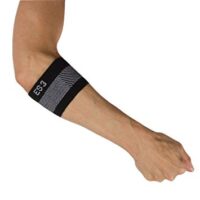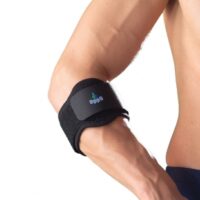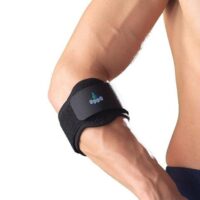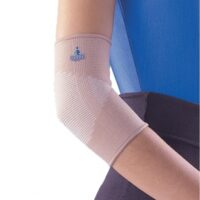Olecranon Bursitis
Article by Zoe Russell
Olecranon Bursitis
What is Olecranon Bursitis?
Olecranon bursitis, commonly known as ‘student’s elbow’, arises when the bursa at the elbow tip becomes inflamed. This bursa, a small fluid-filled sac, plays a crucial role in reducing friction between tendons and bones around joints. It often inflames due to trauma, such as a fall or a hit, or through repetitive actions like throwing or excessive leaning on the elbow.
Recognising the Symptoms
The hallmark signs of olecranon bursitis include swelling and pain at the back of the elbow. These symptoms worsen when leaning on the elbow or during elbow movements, particularly when straightening or fully bending it.

Underlying Causes: More Than Just an Injury
While physical impact is a common cause, olecranon bursitis can also stem from internal factors. Repetitive trauma from certain activities, poor muscle control, or technique during sports can gradually inflame the bursa. Moreover, it can be a secondary issue linked to chronic conditions like fibromyalgia or rheumatoid arthritis.
Diagnosis: The First Step to Recovery
A healthcare provider, typically a doctor or physiotherapist, starts with a physical examination, focusing on elbow swelling. Advanced diagnostic tools like ultrasound or MRI may be used for a definitive diagnosis.
Treatment
Treatment primarily aims at managing pain and reducing inflammation. This includes ice therapy and anti-inflammatory medications.
In some instances, a corticosteroid injection may be administered to kickstart healing. However, the cornerstone of treatment lies in rehabilitation, focusing on preventing the olecranon bursa being traumatised.
Surgery, though rare, becomes an option in persistent cases, involving the removal of the inflamed bursa.
Recovery Timeline and Expectations
Recovery varies, with some cases resolving within weeks, while chronic situations might take months. With proper management and rehabilitation, most individuals see significant improvement within six weeks.
Prevention: A Key Aspect
Preventive measures are as important as treatment. They include avoiding repetitive elbow strain, maintaining good physical condition, and using proper techniques during activities. Regular exercises to strengthen the muscles around the elbow also play a crucial role in prevention. Your sitting posture at your workstation or student desk is also critical.
Conclusion: Your Health, in Your Hands
Olecranon bursitis, while painful, is manageable with the right approach. Understanding the condition, recognising its symptoms, and seeking timely professional advice are essential steps. Physiotherapists offer not just treatment but also guidance on prevention and maintenance. If you experience persistent elbow pain, it’s crucial to seek the advice of a physiotherapist or your doctor.
Takeaway: Don’t Ignore Elbow Pain
Ignoring symptoms can lead to chronic issues. Early intervention by a physiotherapist can ensure a quicker and more effective recovery. Remember, taking care of your elbows is taking care of your active life.
Rochedale - Call 38410277
Book Online: RochedaleSalisbury - Call 32751044
Book Online: SalisburySandgate - Call 32691122
Book Online: SandgateElbow Pain Causes, Diagnosis, and Effective Physiotherapy Management
Introduction
Elbow pain, a common ailment affecting people of all ages, can disrupt daily activities and diminish quality of life. This article, informed by physiotherapist insights, explores the various causes of elbow pain, emphasising the importance of early diagnosis, accurate assessment, and tailored physiotherapy interventions.
Understanding Elbow Pain
Elbow pain can stem from various sources, ranging from tendinopathy to nerve compression. Identifying the root cause is key to selecting the most effective treatment.


Common Elbow Pain Causes
Tennis Elbow and Golfer's Elbow:
Tennis Elbow and Golfer's Elbow, caused by overuse or strain of the elbow tendons, are prevalent among athletes and those engaging in repetitive arm movements. More info: Tennis Elbow, Golfer Elbow.
Olecranon Bursitis:
Olecranon Bursitis is inflammation of the bursa near the elbow joint leads to pain and swelling.
Youth Elbow Pain:
Conditions like Thrower's Elbow and Little League Elbow are common in young athletes due to repetitive stress. More info: Youth Arm Pain
Neck-Related Arm Pain:
Issues in the neck, like Cervical Radiculopathy or Neck Arm Syndrome can manifest as elbow pain.
Muscle-Related Pain:
Muscle strains and repetitive strain injuries (RSI) often present as elbow discomfort.
Medical Conditions:
Stress fractures, fibromyalgia, and various types of arthritis can also lead to elbow pain.
Recent Research Insights
Recent studies highlight the effectiveness of targeted physiotherapy in treating elbow pain. Techniques such as manual therapy, specific exercises, and other therapies have shown promising results in reducing pain and improving function.
The Role of Physiotherapy in Treating Elbow Pain
Physiotherapy plays a crucial role in the management of elbow pain, focusing on alleviating discomfort and restoring normal function.
Key Physiotherapy Interventions
- Personalised Exercise Programs: Tailored exercises to strengthen and stretch the affected muscles.
- Manual Therapy: Hands-on techniques to improve joint mobility and reduce pain.
- Pain Management: Use of modalities like ice, heat, and ultrasound to manage pain and inflammation.
- Education and Advice: Guidance on activity modification and ergonomics to prevent recurrence.
The Importance of Early Intervention
Early physiotherapy intervention can prevent the progression of symptoms and facilitate a quicker return to daily activities.
When to Seek Professional Advice
Consult a physiotherapist or doctor if you experience persistent or worsening elbow pain. They can conduct a comprehensive assessment and develop a personalised treatment plan.
What to Do?
If you're experiencing elbow pain:
- Rest: Avoid activities that exacerbate the pain.
- Apply Ice: To reduce swelling and pain.
- Seek Professional Help: A physiotherapist can provide expert advice and treatment.
Conclusion
Elbow pain, though common, can be effectively managed with physiotherapy. Understanding the cause, seeking early treatment, and adhering to a personalised care plan are vital for a successful recovery.
For more detailed information on elbow pain causes and treatments, visit PhysioWorks, where you can find resources and professional advice tailored to your condition.
Rochedale - Call 38410277
Book Online: RochedaleSalisbury - Call 32751044
Book Online: SalisburySandgate - Call 32691122
Book Online: SandgateArticle by John Miller
Tennis Elbow Brace
Your Guide to Pain Relief and Recovery
Tennis Elbow Braces: A Physiotherapist's Guide
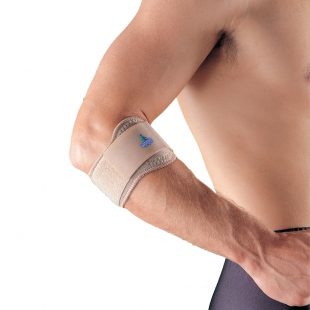

What is a Tennis Elbow Brace?
A tennis elbow brace offers vital support to an injured elbow, aiding in the healing process. It works by shifting the forces away from the affected elbow area, alleviating pain, and providing protection.
Does a Tennis Elbow Brace Offer Immediate Pain Relief?
Many individuals experience immediate pain relief with a tennis elbow brace, allowing a return to normal activities. However, if pain persists, it's essential to consult a physiotherapist for a thorough assessment and treatment plan.
How to Use a Tennis Elbow Brace Effectively
For optimal effectiveness, position the brace around the widest part of your forearm, especially during activities that trigger pain. This placement helps reduce pain and strengthen grip for those suffering from tennis or golfers elbow.
Further Reading and Resources
- Elbow-Related Arm Pain
- Tennis Elbow
- Golfers Elbow
- Olecranon Bursitis
- Juvenile Osteochondritis Dissecans
- Cervical Radiculopathy
- Neck Arm Pain
Conclusion
Embracing a tennis elbow brace as part of your recovery regimen can significantly aid in the healing process. Remember, consulting a physiotherapist for tailored advice is crucial for a successful recovery journey.


















